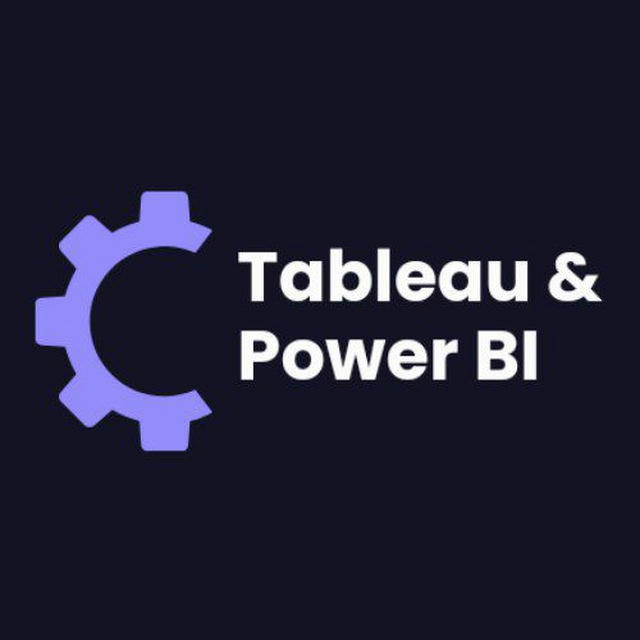
Microsoft Power BI | Tableau | Data Visualization
🆓 Resources to learn Power BI, Tableau & Data Visualisation Admin: @coderfun
نمایش بیشتر20 266
مشترکین
+32524 ساعت
+9757 روز
+3 16830 روز
- مشترکین
- پوشش پست
- ER - نسبت تعامل
در حال بارگیری داده...
معدل نمو المشتركين
در حال بارگیری داده...
DAX Functions Part-2
DAX Part-1: https://t.me/PowerBI_analyst/150
### Table Manipulation Functions
These functions perform operations on tables. Examples include:
- ADDCOLUMNS: Adds calculated columns to a table.
NewTable = ADDCOLUMNS(Sales, "DiscountedAmount", Sales[Amount] * 0.9)
SummaryTable = SUMMARIZE(Sales, Sales[ProductID], "TotalSales", SUM(Sales[Amount]))
FullName = CONCATENATE(Employees[FirstName], Employees[LastName])
LeftPart = LEFT(Product[ProductName], 5)
UpperCaseName = UPPER(Product[ProductName])
TotalSalesYTD = TOTALYTD(SUM(Sales[Amount]), Sales[OrderDate])
LastYearSales = CALCULATE(SUM(Sales[Amount]), SAMEPERIODLASTYEAR(Sales[OrderDate]))
SalesLast30Days = CALCULATE(SUM(Sales[Amount]), DATESINPERIOD(Sales[OrderDate], LASTDATE(Sales[OrderDate]), -30, DAY))
❤ 7👍 4💯 1
نمایش همه...
Power BI Learn - practical approach
Who want to learn power bi and SQL...join this channel
HOW TO LEARN POWER BI IN 2024 👇👇
🔺Get Familiar with Basics: Start by understanding the basics of Power BI, such as data sources, data modeling, and visualization concepts.
🔺Install Power BI Desktop: Download and install Power BI Desktop, the free version of Power BI, to begin creating reports and dashboards on your local machine.
🔺Explore Sample Data: Use sample datasets provided by Power BI to practice creating visualizations and getting comfortable with the interface.
🔺Learn Data Loading: Understand how to import data into Power BI from various sources, including Excel, databases, and online services.
🔺Data Transformation: Learn the process of cleaning and transforming data using Power Query to ensure it's suitable for analysis.
🔺Data Modeling: Grasp the fundamentals of data modeling, including relationships between tables, creating calculated columns, and measures.
🔺Create Visualizations: Practice creating different types of visualizations like charts, tables, and maps to represent your data effectively.
🔺Master DAX (Data Analysis Expressions): DAX is the formula language used in Power BI. Learn how to create calculated columns, measures, and calculated tables using DAX.
🔺Build Dashboards: Combine visualizations into interactive dashboards to convey insights effectively. Understand how to use filters and slicers.
🔺Publish to Power BI Service: Explore Power BI Service, where you can publish your reports and share them with others. Learn about collaboration features.
🔺Explore Advanced Features: Dive into advanced features like Power BI Apps, Power Automate integration, and Power BI Embedded for more sophisticated applications.
🔺Stay Updated: As Power BI is regularly updated, stay informed about new features and improvements. Join online communities or forums to connect with other Power BI users and learn from their experiences.
👀🧠Remember, consistent practice and real-world projects will enhance your skills. Utilize online resources, tutorials, and documentation provided by Microsoft to deepen your understanding.
00:09
Video unavailableShow in Telegram
🚀🚀BIG NEWS: Crypto Pros Predict 50x Potential for $BCCOIN!
Why Invest in $BCCOIN?
✨World’s First Limitless Crypto Credit Card:
No fees, limitless spending, and real crypto integration.
✨ Imminent Tier 1 Exchange Listings:
Major listings soon, increasing visibility and demand.
✨ Explosive Growth Potential:
Experts predict 50x returns in the next two weeks.
✨ $200M Joint Venture:
Strong institutional interest and major partnerships on the horizon.
✨Last Call Before Big Launch:
Major launch on WorldPress coming soon. Act now!
How to Invest:
🔗Buy & Stake Now
🔗Buy in CEX
🔗Buy in DEX
Join Our Community:
Telegram Channel
Audit Reports:
- CertiK Audit
- Hacken Audit
Don't miss this revolutionary opportunity! 🚀💰
If you're looking to build a career in Data Analytics but feel unsure about where to start, this post is for you.
It's important to know that you don't need to spend money on expensive courses to succeed in this field.
Many posts you see on LinkedIn promoting paid courses are often shared by individuals who are either trying to sell their own products or are being compensated to endorse these courses.
Through this post, I will share with you everything you need to start your data journey absolutely free.
🔗 Source
Hope it helps :)
👍 11🔥 2
نمایش همه...
Power BI Learn - practical approach
Who want to learn power bi and SQL...join this channel
Power BI DAX Functions PART-1
### Aggregation Functions
Aggregation functions perform calculations on a set of values and return a single value. Common aggregation functions include:
- SUM: Adds all the numbers in a column.
TotalSales = SUM(Sales[Amount])
AverageSales = AVERAGE(Sales[Amount])
MinSales = MIN(Sales[Amount])
MaxSales = MAX(Sales[Amount])
DateValue = DATE(2023, 12, 31)
CurrentDate = TODAY()
YearValue = YEAR(Sales[OrderDate])
DateDifference = DATEDIFF(Sales[OrderDate], Sales[ShipDate], DAY)
FilteredTable = FILTER(Sales, Sales[Amount] > 1000)
AllSales = CALCULATE(SUM(Sales[Amount]), ALL(Sales))
RelatedValue = RELATED(Product[ProductName])
IsBlankCheck = ISBLANK(Sales[Amount])
IsNumberCheck = ISNUMBER(Sales[Amount])
IsErrorCheck = ISERROR(Sales[Amount] / Sales[Quantity])
Discount = IF(Sales[Amount] > 1000, 0.1, 0.05)
AndCheck = AND(Sales[Amount] > 1000, Sales[Quantity] > 10)
OrCheck = OR(Sales[Amount] > 1000, Sales[Quantity] > 10)
AbsoluteValue = ABS(Sales[Amount])
RoundedValue = ROUND(Sales[Amount], 2)
PowerValue = POWER(Sales[Amount], 2)
Path = PATH(Employees[EmployeeID], Employees[ManagerID])
PathItem = PATHITEM(Path, 2)
RelatedValue = RELATED(Product[ProductName])
RelatedTable = RELATEDTABLE(Sales)👍 13
نمایش همه...
TrueMinds | Words of Wisdom
Real Knowledge that MATTER! The best channel to lift you up! Buy ads:
https://telega.io/c/truemindsAdded one amazing book called data visualisation made easy with these resources. Give me it a read whenever you get time ❤️
👍 5❤ 2
